Whales: Playing together….
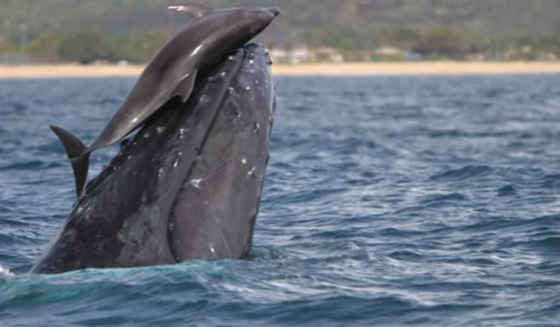
From my friend Carol:
In recent years years, bottle-nose dolphins were documented riding humpback whales in Hawaiian waters. The dolphins actually slide down the backs of the whales into the water like a makeshift “slip and slide.”
Scientists believe it is just a game between the two species, because neither of them displays aggressive or distressed behavior toward the other. It seems to be play-time that they both genuinely enjoy. When the dolphins are riding on the whales’ backs, the whales will sometimes go up to the surface and lift the dolphins into the air. The interactions are rare or at least, very difficult to capture on camera.
More about it on YouTube:
Whales: Keller & the dolphin both make each other’s lives better….
What do you do when a friend asks for help? Easy answer.
Keller Laros was diving when a dolphin came & asked for help. I honestly believe this little video will change your day.
Thanks, Keller & Martina (who shot the footage)!
Whales: Attack by killer whale…unlikely, according to expert
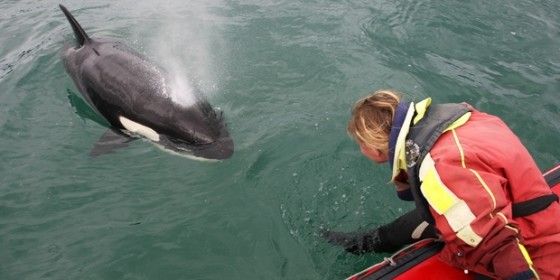
Human/killer whale attacks are rare, which prompts this expert in New Zealand to suggest this event was unfortunate, but more of an accident – here’s more:
An expert on marine animals is skeptical about reports of an orca grabbing a free diver’s catch bag and dragging him underwater until the rope became free.
Whale rescue co-founder, Far North-based Jo Halliday said it was not unheard of for such an incident to occur but she doubted it was a case of “whale attacks man”.
Levi Gavin, who was diving for kina and crayfish two weeks ago at Horahora estuary, on the coast east of Whangarei, said he was dragged beneath the water for about 40 seconds after the orca grabbed the catch bag tied to his right arm.
Mr Gavin described being down to his “last breath” in a death spiral, and trying to relax to conserve his breath as the huge creature dragged him deeper and deeper.
Whales: Monika, with the grey whales in Baja
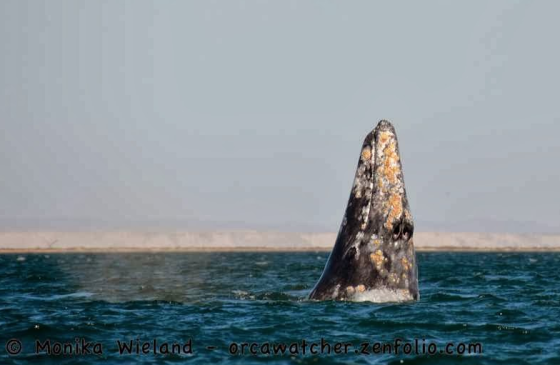
I love to read Monika Wieland‘s take on the way things work in the natural world…she writes so well & you already know I’m a fan of her pictures!
Here’s her report from Baja, with her first day on the water, with her observations & photos.
Whales: Capturing our brother & sister killer whales, in Russia
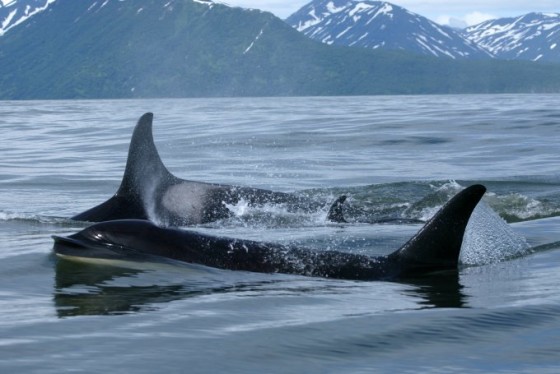 If the marine entertainment industry folks tried to capture orcas in Atlantic waters, or off the Pacific coast….you bet there would be a fight.
If the marine entertainment industry folks tried to capture orcas in Atlantic waters, or off the Pacific coast….you bet there would be a fight.
So they’re doing it in the cold seas of Russia. According to Erich Hoyt:
Four more orcas have now been confirmed to have been captured in Russian waters for ocean amusement parks and aquariums. That makes seven total captured in the past 2+ months in two separate captures in the Sea of Okhotsk—the massive far eastern inland sea of Russia, lying due north of Japan. Having spent time with these wild, beautiful orcas, I feel personally, as well as professionally, depressed about these developments.
The first 2013 capture happened in mid-August. The three orcas, or killer whales, were taken by a Russian catching team, the same team that caught a female orca in the same general area at the same time last year. For the past year, that young female — someone named her Narnia and the name stuck — has been swimming alone in a tiny makeshift pen near Nakhodka (Vladivostok area), awaiting her fate. The rumors have consistently pointed to her eventual transfer to Moscow.
Whales: Killer whales seen off Kona, Hawaii
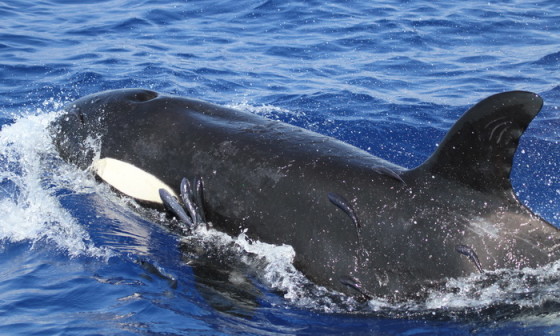
There is no known resident pod of orcas around Hawaii, which makes it that much more exciting – and that much more rare – when they are seen.
Here’s more from Pete Thomas Outdoors about last week’s sighting, and what it means.
Whales: Welcome home, old friend….”They are fishermen, like we are.”
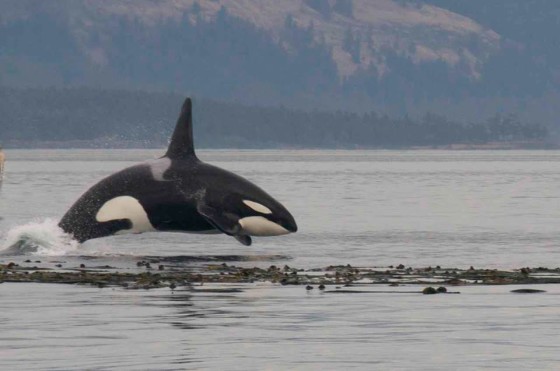
Just what you want to hear. And yeah, more than a coincidence.
On Tuesday, killer whales came close to a ferry from Seattle as it approached Bainbridge Island. The killer whales surrounded the ferry and splashed in the water.
By coincidence, on board the ferry were officials from The Burke Museum in Seattle who were returning tribal artifacts to the new Suquamish Museum. The artifacts were dug up nearly 60 years ago from the site of the Old Man House, the winter village for the Suquamish tribe and home of Chief Seattle.
Also on board was Suquamish Chairman Leonard Forsman. He believes the appearance of the orcas was no coincidence. He believes they were welcoming the artifacts home to the reservation.
Whales: Interspecies love….
If dolphins & dogs can get along….
You’ve kissed people – did you ever see anyone jump like this, afterwards?
from One World, One Ocean
Whales: What do you do when a humpback takes a swipe at you?
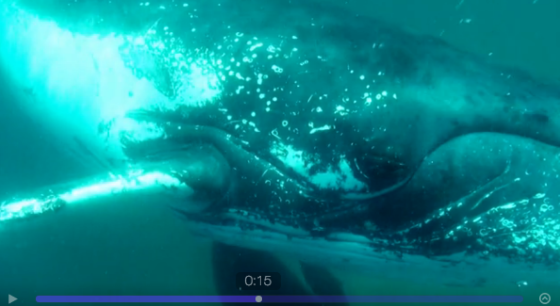
When freediver Chris Coates was swimming off the coast of Africa, he had seen humpbacks all day….but this one came close & thumped him with its pectoral fin. You can see his amazing video & the rest of the story here – check it out!
Whales: Plastic in the gut – it’s a killer
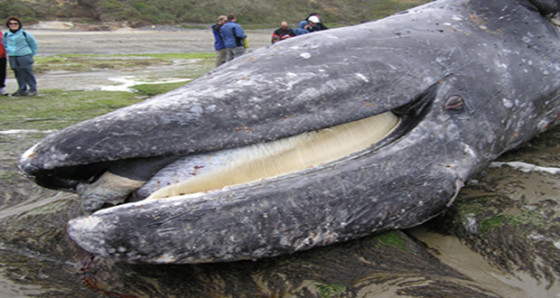
Ever since I met Captain Charles Moore a few years ago (he came to San Juan Island for a rousing talk), I’ve had plastics on the brain. If you haven’t seen his here’s-everything-in-a-nutshell TED talk, check it here.
The amount of plastic in the world’s oceans is staggering, and it makes its way into the animals who live there. I’m happy to see that people like Angela Sun are making documentaries about this (here’s her trailer for her film, Plastic Paradise):
Plastic Paradise: The Great Pacific Garbage Patch Trailer from Angela Sun on Vimeo.
This is not isolated to any one part of the world – it is everywhere. The whale in the photo above died because it was filled with plastic waste, and there’s a lesson in its death about the direction it – and we – as a species are headed.
Here’s the rest of the story, from CS Globe.
Whales: Meet Ken & check in on the orcas, with Carl Safina
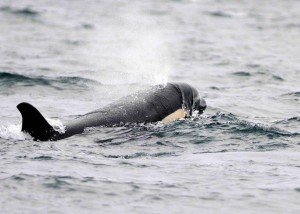
Carl Safina came to San Juan Island in Washington State to see what’s happening with the killer whales, and to hang out with the Center for Whale Research’s Ken Balcomb.
The state of the environment for the orcas: short on food, and decreasing numbers in the resident pods. It doesn’t help that the Navy does sonar testing in these waters, either.
Carl files this report. (click here)
Whales: Watch a humpback in action (it’s like riding a whale….)
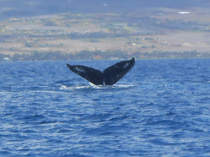
Here’s a story you’ll find fascinating: NOAA shares research showing how humpbacks manage their bottom-feeding, including eating sand lance (sand eels.) And you can watch, as they attach a “crittercam” to the whale to actually see it in action.
Whales: A friend, close at hand
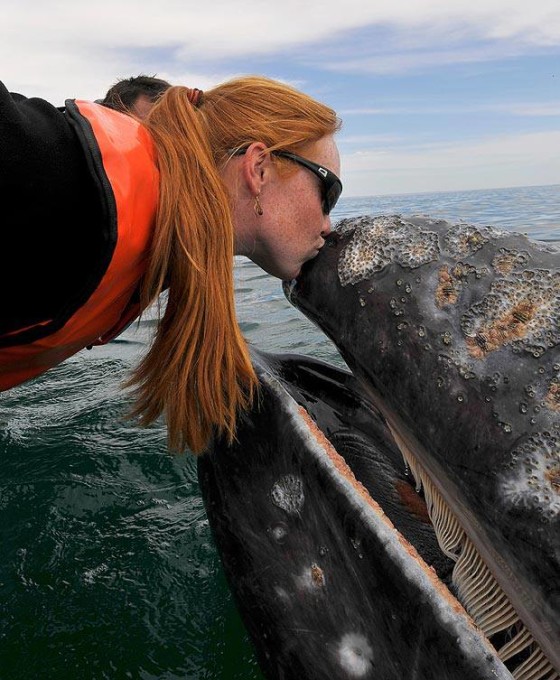
Whales: Photobomb by a dolphin, sharing the wave
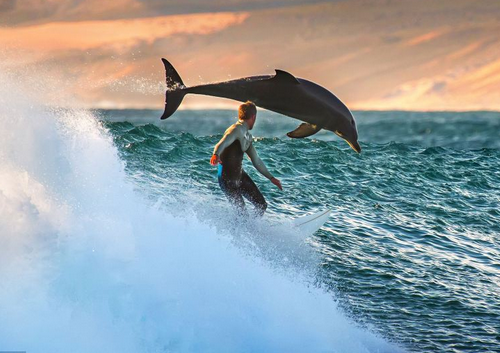
A photographer was trying to line up this picture of a surfer, but a dolphin came by.
Result: Awesome photo.
Here’s the story in the Daily Mail.
Whales: Twenty years after “Free Willy,” what have we learned, and what have we missed…
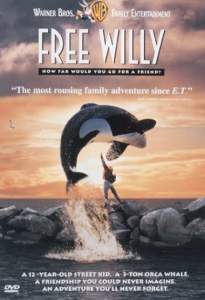
Do you remember where you were, the first time you saw Free Willy? For me, it was in a movie theatre in Eugene, OR, USA, with a packed house that screamed & cheered & clapped when Willy gets away at the end (see the poster at right, for spoiler). It was a football game where the home team won, a fairy tale that wasn’t Grimm, it was a tale of justice, unpeeled. It was awesome.
One of the byproduct events of the movie was the eventual real-life release of the whale who played Willy, a captive killer whale named Keiko. Was this a good idea? DId it work out? Did humans learn anything from the experience about orcas, or about themselves?
I got to shake David Kirby’s hand last summer when he was passing through Friday Harbor (WA) on a promotional tour for his new book, Death at SeaWorld. I found him thoughtful, articulate, and an impassioned warrior against marine mammal captivity. Reading Death at SeaWorld made want to read the article linked below.
He shares his take on what we could have learned, what we missed, and perhaps what lies ahead in this penetrating essay. Let me know what you think.
Here’s the link to David Kirby’s remarks about Keiko on the 20th anniversary of Free Willy.
And…. here’s the trailer for the movie, back then.
Still endangered? NOAA reviews what’s next for humpbacks…
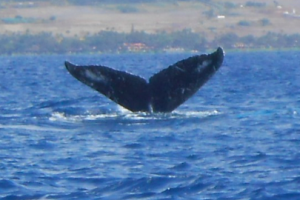
My friends at Whale Trust in Maui tell me that the National Oceanic and Atmospheric Administration is set to review whether humpbacks will remain protected as an endangered species, or whether their status would be downgraded to “threatened.”
The issue includes checking to see if the North Pacific humpback should be considered as a separate species, as well.
Here’s more from Alaska Public Media.
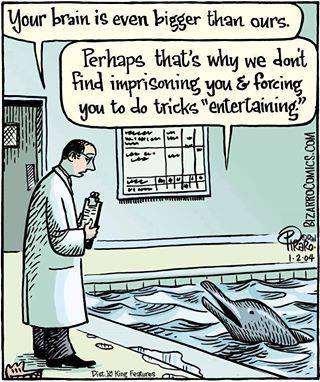
 Over the centuries, Brother Ian has been collecting stories & information & discourses for the purpose of elevating the human condition as needed, dissecting it when necessary, and building the case for hope.
Over the centuries, Brother Ian has been collecting stories & information & discourses for the purpose of elevating the human condition as needed, dissecting it when necessary, and building the case for hope.